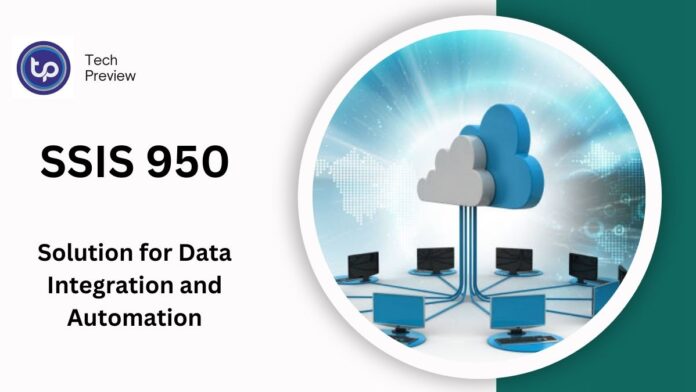In today’s data-driven world, businesses rely heavily on integrating vast amounts of information across various platforms. SQL Server Integration Services (SSIS) has long been a trusted name in this field, offering an effective way to move, transform, and load data across systems.
The release of SSIS 950 brings a set of advanced tools and features that enhance data integration and automation capabilities.
In this article, we’ll explore why SSIS 950 is an industry-leading solution, delving into its functionality, real-world applications, and how it simplifies complex data integration tasks.
What is SSIS 950?
SSIS 950 is the latest version of SQL Server Integration Services, a component of Microsoft SQL Server. SSIS is designed for Extract, Transform, and Load (ETL) operations, which are essential in data warehousing and business intelligence (BI) applications.
SSIS 950 streamlines data extraction from multiple sources, allows for data transformation, and loads the data into a destination such as a data warehouse, cloud storage, or enterprise database. The flexibility and scalability of SSIS make it a top choice for organizations looking to integrate large datasets efficiently.
Key Features of SSIS 950
SSIS 950 comes with a range of new features that improve data handling, security, and performance:
- Improved Connectivity:
- SSIS 950 includes enhanced connectors that allow seamless integration with Azure services, NoSQL databases, Oracle, and more. This enables businesses to combine their on-premises and cloud data sources effortlessly.
- Built-in connectors for platforms like Amazon S3, Salesforce, and Google BigQuery make SSIS 950 a versatile tool for various industries.
- Advanced Data Transformation:
- SSIS 950 provides new data transformation tools, including advanced mapping features that allow developers to handle complex data relationships.
- Conditional split transformations allow businesses to dynamically separate data based on conditions, enabling more refined control over data flow.
- Data Flow Optimization:
- The engine is designed for parallel processing, enabling faster data flow between multiple sources and destinations. This results in improved performance when handling large datasets.
- SSIS 950’s Pipeline Engine reduces bottlenecks by optimizing data transfer rates, ensuring high throughput even during peak loads.
- Improved Security:
- SSIS 950 includes data encryption for secure data transfer, both on-premise and in the cloud.
- Row-level security allows data managers to control access and permissions based on user roles, ensuring compliance with privacy laws such as GDPR and CCPA.
- Integration with Machine Learning:
- SSIS 950 seamlessly integrates with Azure Machine Learning and other AI platforms, allowing businesses to apply machine learning models to their datasets before loading the data into a destination.
- This feature is particularly valuable for organizations looking to automate predictive analytics within their existing data workflows.
Use Cases of SSIS 950
SSIS 950 is widely used across different industries thanks to its flexibility and robustness in handling data. Here are some common use cases where SSIS 950 proves invaluable:
- Data Warehousing: SSIS 950 allows organizations to create and manage data warehouses efficiently. Businesses can generate better BI reports and dashboards by extracting data from various sources, transforming it according to business rules, and loading it into a centralized warehouse.
- Cloud Data Integration: With built-in connectors for cloud services like Azure, AWS, and Google Cloud, SSIS 950 simplifies data movement between on-premises systems and cloud-based platforms. This is especially important for companies adopting a hybrid cloud strategy.
- ETL Automation: SSIS 950 offers tools to automate ETL processes for businesses dealing with large datasets. This reduces manual intervention, decreases human error, and ensures timely updates to data repositories.
- Business Intelligence and Reporting: SSIS 950 works seamlessly with SQL Server Reporting Services (SSRS) and other BI tools to automate the generation of real-time reports. Organizations can gain deeper insights into their business processes with minimal effort.
Benefits of Using SSIS 950
- Scalability: SSIS 950 is built to handle projects of all sizes, from small-scale data integration tasks to large enterprise-wide initiatives. Whether you are working with terabytes of data or integrating multiple databases, SSIS scales efficiently to meet your needs.
- Ease of Use: SSIS 950 comes with a drag-and-drop interface within the Visual Studio environment, allowing developers to create data integration workflows without writing complex code. This makes SSIS accessible even for less experienced developers.
- Customization: While SSIS offers many built-in functionalities, developers can use custom scripts (written in C# or VB.NET) to create tailored data transformations or connect to non-standard data sources.
- Cost-Effective: As part of the SQL Server suite, SSIS 950 offers excellent value for businesses already using the Microsoft ecosystem. With no additional licensing required for SQL Server users, SSIS is a cost-effective solution for businesses.
- Reliability: SSIS 950 is known for its reliability in handling large-scale ETL jobs. Its ability to manage error-handling, logging, and transaction control ensures data integrity throughout the integration process.
How SSIS 950 Enhances Data Integration
One key benefit of SSIS 950 is its ability to integrate data from disparate sources. Whether dealing with relational databases, cloud services, or flat files, SSIS 950 simplifies the process of combining these data into a unified system. This is crucial for businesses looking to make data-driven decisions.
SSIS 950 also excels in data transformation, allowing organizations to clean, filter, and enrich their data before analysis. This ensures that only high-quality data is used in decision-making processes, leading to more accurate insights and improved business outcomes.
SSIS 950 vs. Other Data Integration Tools
While several data integration tools are on the market, SSIS 950 stands out for its comprehensive features, flexibility, and integration with the Microsoft ecosystem. Tools like Talend and Informatica offer similar ETL capabilities, but SSIS 950’s deep integration with Azure and ease of use in Visual Studio give it a significant edge for businesses using Microsoft technologies.
Moreover, SSIS 950’s ability to automate workflows without sacrificing performance makes it a preferred choice for large enterprises needing reliable and scalable solutions.
Conclusion
SSIS 950 is a powerful, reliable, and scalable tool offering a data integration and automation solution. With its improved connectivity, data transformation capabilities, and advanced security features, it’s a must-have for businesses seeking to streamline their data processes.
Whether you’re building data warehouses, integrating cloud services, or automating ETL workflows, SSIS 950 provides the tools needed to tackle the complexities of modern data management.
As businesses increasingly rely on data-driven decision-making, SSIS 950 will continue to be a go-to solution for organizations looking to integrate and leverage their data for better outcomes.








